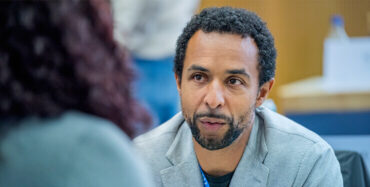
The weight of long-term decisions
Kevin Gabriel often finds himself across the table from prospective suppliers, knowing that the terms negotiated in just a few hours will shape partnerships that last for years. As Senior Project Manager at Roche in Basel, Gabriel is responsible for large-scale pharmaceutical engineering projects and the multi-million Swiss franc contracts that support them.
“These aren’t just procurement decisions,” Gabriel reflects. “When you’re building a high-rise building, comprising of a chemical scale-up facility with complex reactor systems, you’re not just buying equipment – you’re choosing partners for a multi-year journey.”
More than a zero-sum game
Before attending IMD’s Negotiating for Value Creation program, Gabriel admits he was acting mostly on instinct.
“I was always prepared, but mostly driven by gut feeling. Sometimes I’d make the right call, other times I didn’t. I acted as I thought was best, but I didn’t fully comprehend the mechanics of negotiation.”
Like many professionals, he’d internalized the classic zero-sum mindset: one side wins, the other loses. It’s a perspective that might deliver short-term budget victories, but in his role, Gabriel was beginning to see its long-term costs.
“You might squeeze out a better deal upfront, but then you still have to work with someone who feels they got the losing end of the deal for the next three years. And that hurts the relationship.”
That was when Gabriel began to recognize the alternative: instead of fighting over slices of a fixed cake, good negotiators look for ways to make the cake bigger, first. By uncovering each other’s interests, both sides can often leave the table with more than they expected – and with a stronger relationship.
Creating value: learning to grow the pie
For Gabriel, this shift came during the program, through a negotiation exercise involving eggs. The setup was simple: three groups needed different parts; one the shells, another the whites, the third the yolks. The catch: none had the budget to buy whole eggs alone, and no group knew what the others needed.
“At first it seemed impossible,” Gabriel recalls. “But once we figured out each other’s needs, it became obvious: we could buy the eggs together and share them. That was creating value.”
The lesson stayed with him: creating value begins with empathy and curiosity — taking time to put yourself in the other party’s shoes. “Sometimes what matters to them doesn’t cost me much to give,” he explains.
In practice, that might mean combining different elements of a contract so both sides benefit – for example, linking a core purchase with a longer-term service agreement. “If you understand what’s important to them, you can often structure something that strengthens the relationship and improves the outcome for both.”
Capturing value: the other half of the equation
But the exercise had a second, harder lesson: that capturing value was critical, too.
“Some groups were much better than others at capturing value. My group didn’t do particularly well. It showed me that it’s not enough to be creative, you also have to make sure you bring value back to your organization.”
This balance between creating and capturing value became his guiding principle: make the cake bigger, but also ensure your organization gets its fair share.
Building skills to do both
The learning journey gave Gabriel tools to act on these insights. He describes becoming much more conscious about how he negotiates, learning to ask better questions and use information strategically.
He also found that much of the learning came not just from the faculty, but from his peers. As an introvert, the idea of intensive networking initially felt daunting. But IMD’s design – from changing seats each day to coffee breaks without phones and interactive role-play exercises – made connecting feel natural, rather than forced.
“The setup created space for real conversations, And those conversations turned into genuine connections.”
Peers from different industries and cultures offered perspectives he might never have considered.
He was struck by how approaches to negotiation can vary across regions. “What works in Europe might look very different in Asia or the Middle East. Hearing how others navigate those dynamics broadened my perspective and gave me new tools to adapt my style.”
The program‘s case studies reinforced these lessons. “I’ve never been a fan of exercises, because I thought they were mostly unrealistic games. But these felt real, and my peers took them seriously. You could immediately apply what you’d learned.”
That practice proved crucial for bringing the lessons back to work. “When you just sit in a classroom hearing theory, you go home saying it was a good lecture. But applying it is much harder. The program helped me practice in a safe environment first.”
Finding value in everyday negotiations
Back at work, Gabriel realized that formal negotiations are only a small fraction of the picture. “Maybe 10 percent of negotiations are the big, formal ones,” he reflects. “The other 90 percent happen in everyday interactions.”
Those day-to-day moments might look casual, but they are still negotiations: aligning on technical solutions, agreeing on timelines, or discussing project details. Often, they happen over coffee, in the corridor, or during lunch.
“That’s where the same principles really apply,” Gabriel explains. “If you take the time to understand what matters to the other person, even in a quick chat, you build trust and uncover opportunities. And when you eventually get to the formal negotiation, everything flows much more smoothly.”
It works at home, too
Gabriel soon noticed that the same principles carried over into his personal life, especially in the morning rush with his two young daughters.
“In the mornings we have to get them ready; I need to go to work, they need to go to school or kindergarten. And suddenly, they want to wear different shoes or clothes,” he explains. “For me, as an adult, it doesn’t really matter which shoes they wear. We need to go. But for them it does matter. And when I acknowledge that, when they feel their interests are heard, they’re much more willing to cooperate.”
For Gabriel, it’s a reminder that the same mechanics apply everywhere: whether it’s a multi-million-franc supplier contract or getting children out the door on time, negotiation is less about forcing outcomes and more about understanding interests and finding solutions that work for everyone.
Sustainable success
Today, Gabriel approaches negotiations with a clearer framework and deeper preparation. “I know what questions to ask, how to use information, how to create value. It feels less like me against them – we can create something together that works for both sides.”
The coming year is especially important, with major supplier decisions on the horizon. Gabriel feels ready, but he’s also realistic. “I didn’t come out of the course suddenly as the best negotiator. This is something I need to keep practicing day by day. What the program gave me is the mindset and the tools; now it’s about applying them and getting better over time, one negotiation at a time.”


